

BBC - How to Survive a Nuclear Bomb. TROUBLES COGNI. France - Digital News Report 2014. France has more than 80 daily newspapers.
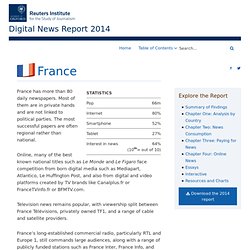
Most of them are in private hands and are not linked to political parties. The most successful papers are often regional rather than national. Online, many of the best known national titles such as Le Monde and Le Figaro face competition from born digital media such as Mediapart, Atlantico, Le Huffington Post, and also from digital and video platforms created by TV brands like Canalplus.fr or FranceTVinfo.fr or BFMTV.com. Television news remains popular, with viewership split between France Télévisions, privately owned TF1, and a range of cable and satellite providers. France’s long-established commercial radio, particularly RTL and Europe 1, still commands large audiences, along with a range of publicly funded stations such as France Inter, France Info, and France Culture.
28_01_15futureofnews.pdf. The year in media: 12 reasons why we should be optimistic. Storyhunter launches an Airbnb-style platform for freelance foreign correspondents. The life of a freelance foreign correspondent can be a difficult one, combining the risk of personal danger — being shot at, kidnapped etc. — with the difficulty of finding steady work, not to mention getting paid.

From Grumpy Cat to Ukraine: How Mashable is expanding beyond gadgets and apps. Within minutes of the first reports that a Malaysia Airlines plane had crashed over eastern Ukraine Thursday, Mashable had live coverage up and running.
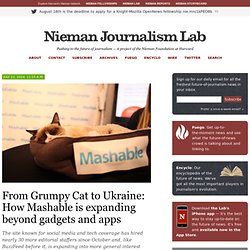
Its real-time news staff in New York was updating the post with videos from the scene and carefully sourced information culled from social media and other outlets; its own social accounts, including its meant-for-breaking-news @MashableLive, were busy pushing out information. Meanwhile in Ukraine, Christopher J. Miller, a Mashable contributor, was working his sources and providing information to the main Mashable story while also writing his own piece as further developments unfolded. Geolocated News Is Going To Change The News Business.
BreakingNews.com and its app have been a gold standard for news aggregation for years: Among news brands, they're often the first mover on Twitter, which is why 6 million people follow them.

And now, with the latest update to its iOS app, this independently run business within NBC News Digital is following their audience back. Last week, Breaking News unveiled "proximity alerts," meaning the app will send users a push notification on their mobile device when news breaks near them--no matter how far from home they may be. On June 13--a day after the update hit the app store--those in the Baltimore area would have gotten a breaking news alert about a tornado, or if you were in Thailand for business the app would have let you know the moment a standing curfew was lifted.
As the company’s GM Cory Bergman explains, “The intent is to look for stories that have a tangible impact for people nearby.” The Financial Times, leader mondial de la transition au numérique. Deux grandes leçons valables pour tous les journaux quelle que soit l’actualité qu’ils couvrent.
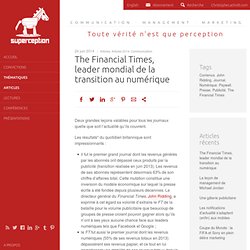
Les journalistes sont-ils de plus en plus déconnectés du réel? – Atelier des ... CNN Newsroom Atlanta A force d'être hyper-connectés à des flux de données, les journalistes risquent-ils d'être de plus en plus déconnectés du réel, au point de de manquer la dimension la plus indispensable de l'information ?

Connectés à la rédaction, déconnectés en dehors Dans une tribune parue cette semaine, le New York Times s’étonnait que la campagne sénatoriale de Virginie ait fait l’objet d’une couverture faible et superficielle dans la presse, laquelle s’est révélée incapable d’analyser précisément les enjeux du scrutin. « Les journalistes sont-ils en train de perdre pieds avec la réalité ? Journalisme en 2014 : la forme privilégiée sur le fond ? Poynter. The best thing I’ve read about the story sharing network Upworthy was written by Katy Waldman for Slate and was republished in my local newspaper, the Tampa Bay Times.

I had been alerted earlier by colleagues to a now famous trademark of Upworthy’s approach to information sharing: its three-line headline style. That style… See Why We Have An Absolutely Ridiculous Standard of Beauty In Just 37 Seconds …has been praised for being irresistibly attractive and attacked for being cynically exploitative. For the moment, I don’t have a dog in that fight. My angle is on the writing front. The good news is more people are reading the news, the hard part is figuring out how to pay for it. To be a journalist or a member of the media in 2014 — or anyone who cares about the future of either or both of those things — is to be caught between two conflicting emotions: One is enthusiasm about the seemingly endless supply of information and the web’s democratization of distribution, and the other is despair about how traditional media business models are failing to keep up.

The latest World Press Trends report on news consumption manages to find support for both of these views. On the bright side, the report from the World Association of Newspapers or WAN-IFRA — which is based on surveys in more than 70 countries — shows that news consumption both in print and online has increased by almost 25 percent in the past year. According to the association, a total of 2.5 billion people consumed the news from printed newspapers in 2013, while 800 million did so online (it’s not clear how the report accounted for potential double-counting). The mobile majority: Engaging people on smartphones is the next big challenge to the news. Editor’s note: The new issue of our sister publication Nieman Reports is out and ready for you to read, online and in print.
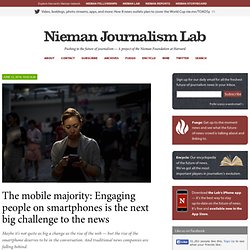
There’s lots of great stuff in there as usual, with articles on the state of journalism education, citizen journalism in Turkey, comics journalism, epic poetry (!) , and more. I write a column for the print edition of the magazine. Here’s mine from the new issue. It almost seems unfair — a case of double jeopardy. Traditional news organizations have spent the past decade responding to an enormously disruptive piece of technology: the web browser. Global digital news audience increased by 23% in 2013. Digital news audiences have risen by 23 per cent in the last year, according to the new World Press Trends report, but publishers are not making the most of their increased audience in terms of revenue.
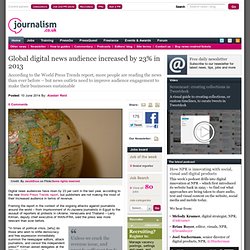
Framing the report in the context of the ongoing attacks against journalists around the world – from imprisonment of Al-Jazeera journalists in Egypt to the assault of reporters at protests in Ukraine, Venezuela and Thailand – Larry Kilman, deputy chief executive of WAN-IFRA, said the press was more relevant than ever before. Unless we crack the revenue issue, and provide sufficient funds so that newspapers can fulfill their societal role, democracy will inevitably be weakenedLarry Kilman, WAN-IFRA "In times of political crisis, [why] do those who wish to stifle democracy and free expression immediately summon the newspaper editors, attack journalists, and censor the independent press?
" The New York Times probably won't implement its brilliant innovation report. 'BBC News should learn lessons from Buzzfeed in digital strategy' Buzzfeed has developed a bigger international audience than BBC News and BBC Worldwide. The New York Times' digital challenges, in 5 charts. The New York Times’ internal Innovation report, leaked after the unexpected ouster of top editor Jill Abramson, brought to light a newsroom culture out of step with changing consumer reading habits. Here, five charts tell the story of the Times’ struggles as it tightens its embrace of digital media.
Digital circulation has been a bright spot for the Times. Since it put up a paywall in 2011, paid digital subscriptions have soared to 799,000 as of the first quarter of this year. La révolution de l'information. Recherche confiance, désespérément ! Q&A: Clark Medal winner Matthew Gentzkow says the Internet hasn’t changed new... The Clark Medal is one of the most prestigious awards in all of academia, awarded to the “American economist under the age of forty who is judged to have made the most significant contribution to economic thought and knowledge.” (Names you might know among previous winners: Paul Krugman, Milton Friedman, Joseph Stiglitz, Steven Levitt, and Larry Summers.)
This year’s honor went to Matthew Gentzkow of the University of Chicago’s Booth School of Business. Gentzkow is a pioneer in the field of media economics; his work, often co-authored with Chicago Booth’s Jesse Shapiro, takes advantage of previously unavailable data on audience, content, and media impact. Austan Goolsbee, also a Chicago Booth professor, commented on Gentzkow’s work in The New York Times: “Before the Internet and advances in computing power, this couldn’t be done,” Mr.
The future of media isn’t about breaking news scoops, it’s about credibility and trust. As I was nursing my 50th cappuccino in Perugia during the recent journalism conference there, a small bomb blew up in my Twitter feed thanks to a keynote presentation by Felix Salmon, in which the former Reuters blogger said that the journalistic obsession with scoops is a form of masturbation.
The Next Buzzfeed? 5 Hot New Websites. USA : moins de TV, plus de mobile. Briefing: The Startup Newsr... on Livestream. 8 Digital Tools Every Journalist Should Try. When Charlie Beckett asked me to join the Polis journalism conference this week at the London School of Economics and Political Science, he showed the depth of his university by asking a surprisingly practical journalism question for a school ranked No. 2 in the world in the research-laden “communication and media studies” field. Beckett wanted to know about the newest digital tools journalists are using to do accountability journalism (which some of us still call watchdog journalism). My first reaction was to mention some of the “golden oldies” Knight Foundation has funded and followed: the encryption software Tor; the investigative paper-tamer Document Cloud and its advanced story-finding cousin Overview; the visual storytelling tool Timeline JS; and the classic crowdmapping application Ushahidi.
I say golden oldies because in digital years a lifetime for a product seems like about 21 months. “Moore’s Law” predicted chip-processing power would double about every 18 months. Related. What will yesterday’s news look like tomorrow? To understand how the news industry has transformed in the past decade and a half, it helps to consider our evolving perceptions of the relationship between news and time. Think of it this way: When’s the last time you saw an A1 above-the-fold headline in print that actually revealed something you hadn’t already heard or seen online? Contemplate the eternity that passes in the 20 minutes between email news alerts from competing media outlets. Even the term “24-hour news cycle” feels obsolete. What do our changing ideas about the relationship between news and time mean for yesterday’s news—including the really old pre-internet stuff, more recent stories published two site-redesigns ago, and the articles that went live this morning?
And how should newsrooms think about archived material given our expectations about access to information in a networked world? It all begins with categorization. Context is everything Comparing Apple and apples.
Presse ecrite. Les sites web et les réseaux sociaux préférés des Français. L’institut Harris Interactive vient de publier plusieurs classements, qui permettent de connaître les sites préférés des Français. Depuis 2010, l’observatoire NetObserver interroge les internautes Français pour savoir quels sont les sites qu’ils préfèrent. Ces classements sont donc basés sur des sondages de 5701 à 18176 personnes, selon les catégories, effectués entre septembre et décembre 2013.
Au total, plus de 30 000 personnes ont été interrogées, la méthode des quotas étant respectée pour garantir la représentativité de l’étude Harris Interactive. Top 10 des réseaux sociaux préférés des Français Premier classement et non des moindres : le top 10 des réseaux sociaux préférés des Français. Top 10 des services de vidéos préférés des Français Ce classement montre, une fois de plus, la suprématie de YouTube. 69,2% des 18 000 répondants préfèrent YouTube pour regarder des vidéos. Top 10 des sites de petites annonces préférés des Français. Content economics, part 5: news. Jan Koum (WhatsApp) : "La publicité sur mobile n'est pas un modèle durable" Avec plus de 400 millions d'utilisateurs actifs, WhatsApp est l'une des plus belles success stories sur mobile. Pourquoi Whatsapp, Facebook et Twitter ont de quoi s’inquiéter. Le même jour - le 20 janvier - Le Monde et le New York Times consacraient un article à la montée de l'innovation en Chine (le premier) et sur les succès fulgurants de WeChat, une application de messagerie mobile chinoise (le second).
Il s'agit, bel et bien, d'un tsunami en gestation d'applications asiatiques parties à la conquête du monde. Features and details of the personal franchise model in digital journalism, with 11 examples. Feb.4. The mobile inevitability: How CNN is prepping for the majority-mobile audience coming in 2014. Q&A: Andrew Golis on matching great journalism with big audiences (and, oh yeah, dollars) Future of News Audiences: what’s next as young fail to become strong news consumers. Presse : quelles stratégies pour augmenter les revenus ? JF FOGEL TENDANCES. The future of news: know thy audience. Future of News Audiences: what’s next as young fail to become strong news consumers. Lecture débat. DLD14: Nick d’Aloisio, le développeur qui voulait rendre les informations “définitives” Artduttitresurlewebaurelienviers-131214030444-phpapp01. NPJ 4:12:13 sciencespo.